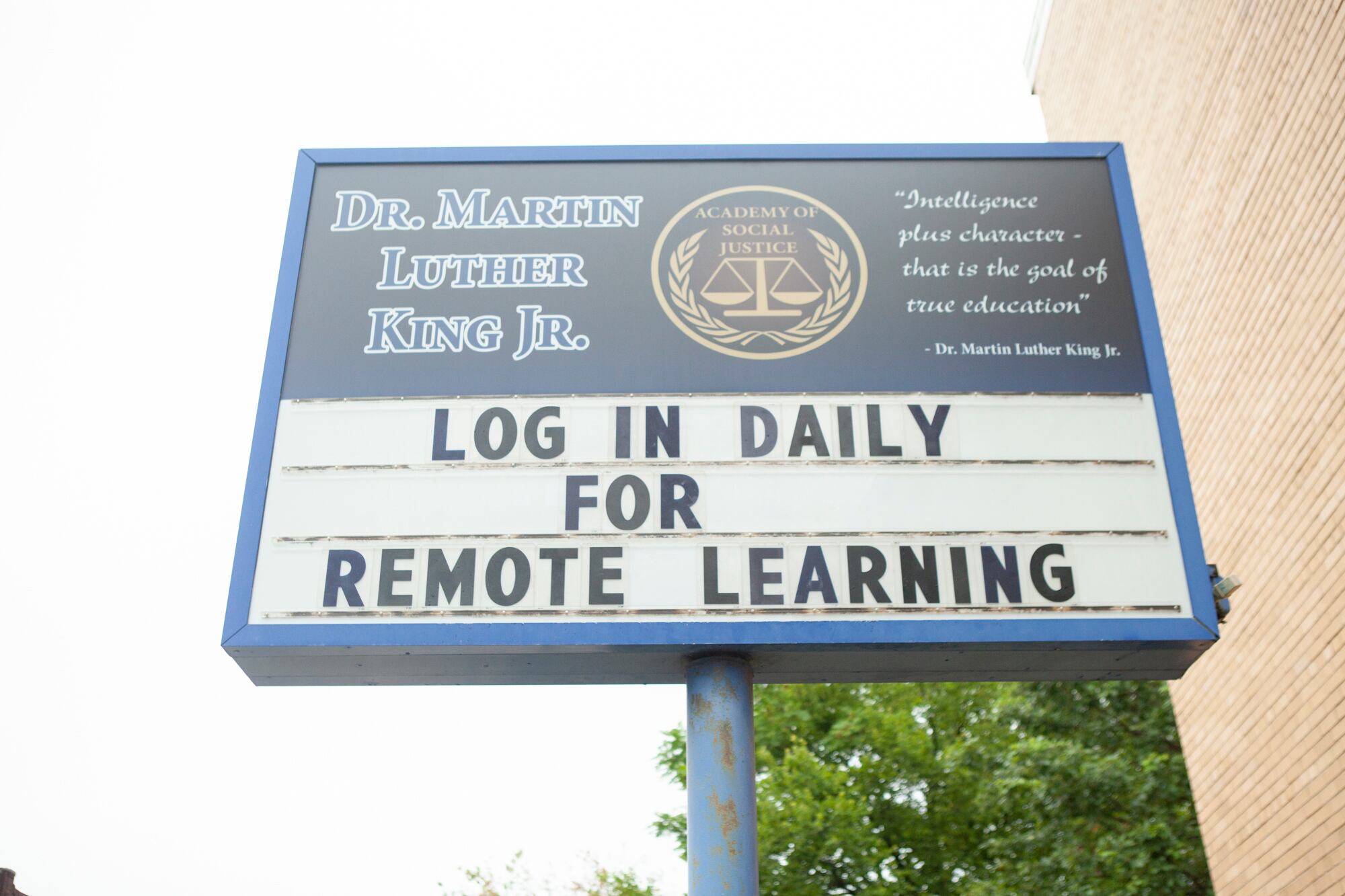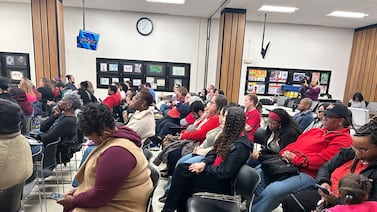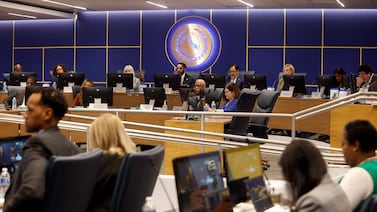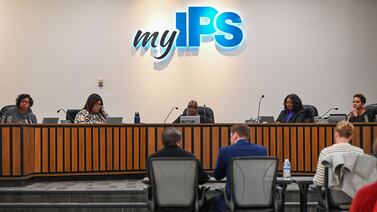At Chavez Elementary on Chicago’s South Side, third-grade teacher Ashley McCall and her colleagues fill out a spreadsheet after each live video class: which students logged on, which showed up late and what might have kept students from attending.
Then come the phone calls and text messages to families.
Chicago is taking a harder line on tracking student attendance this fall and stepping up efforts to boost student participation in live virtual classes. Students must attend those classes to count — and they must log on to each one to be marked as present for the full day.
Like districts across the country, Chicago Public Schools has grappled with how to reimagine its attendance policy for the virtual age — a new conundrum for schools trying to strike a delicate balance between restoring a sense of structure and accountability amid the coronavirus pandemic and giving families grace to account for ongoing challenges.
In Chicago, some parents say that they or their screen-weary students have at times yearned for more latitude to take learning offline or take a break. And some say in the early weeks of the school year, they have gotten conflicting messages about what counts, including being told that students must have their cameras on to be marked as present, which is a departure from district policy that says students should not be penalized for keeping cameras off.
It appears the district’s own guidelines, which said at the start of the school year that elementary teachers would take attendance once a day during homeroom, might have sown some confusion. The district’s most recent available data, from the first week of school, shows slightly more than 90% of students logging on.
District leaders have said engaging in daily learning is crucial to regain academic ground ceded during last spring’s disruption, which some researchers estimate could amount to several months or as long as a school year of lost learning. National experts have stressed that consistent attendance remains critical to student success, even as some urge districts to stay empathetic to students’ needs this fall. Unlike Chicago, some cities are counting students as present even when they fail to log on to live instruction but, say, turn in an assignment.
“Routine does support learning,” said Hedy Chang of the nonprofit Attendance Works. “There’s routine and there’s flexibility. Both are actually really important.”
Chicago officials stress that the district has urged schools to show understanding as families get the hang of virtual learning. That includes not penalizing students for loss of connectivity and other technical issues, even though these are not explicitly on the list of legitimate reasons for missing class in the district’s guidelines.
“The district has instructed teachers to exercise discretion, allowing for flexibility in determining attendance in the event of unforeseen circumstances and in adjustment to the remote learning environment,” said Chicago Public Schools spokesman James Gherardi.
Although Chicago’s first week attendance data represents a dip over the previous fall, district leaders have said they find these numbers encouraging and will continue to push for improved participation.
Calculating attendance
At Chavez, McCall, the third-grade teacher, said the school’s administration took on the task of tracking attendance this fall — both to lighten educators’ load and, during the early weeks, to work through some confusion about how attendance was supposed to work remotely. At the end of the day, after teachers enter attendance for each class in their spreadsheet, a clerk calculates the live instructional minutes that determine if a student is marked as tardy or present for the half or full day.
Guidance from the district says that students in all grades have to attend 100% of the live instruction time to get full-day attendance. If they miss some of that time but log in for more than 150 minutes, they get marked for a half day. Any less than that, and they are marked absent for the day. If a student only attends a portion of a class, they’re marked as tardy.
The district did not address questions from Chalkbeat about what the consequences of a less-than-stellar attendance record this fall will be for students and their families.
But at least at Chavez, McCall says, keeping track of this information is ultimately about troubleshooting any issues that might be keeping students from logging on — not about punishing anyone. Both educators and staff have worked hard to get in touch with all school families, and attendance in third grade at the school has remained above 95% in recent weeks, she said.
“We are continuing our supportive practices, just in the remote environment: ‘So-and-so is not here. Let’s figure out why,’” she said. “Attendance at Chavez is really a schoolwide effort — a priority for everyone.”
The district has said that it is working to check in with the families of students who aren’t logging on to encourage more participation, including training school security guards to make home visits.
But some district parents say the stricter approach to attendance is adding to the pressures of learning from home, as many of them juggle with work and childcare responsibilities.
Joy Coombes, the parent of a fifth grader and an eighth grader, said her children’s teachers at Coonley Elementary on Chicago’s North Side take roll call attendance religiously at the start of each live learning session, with students unmuting to say “here” or typing in the chat.
She said the days in front of the screen can get long for students, especially her son, who has autism. But when she inquired if they could skip their enrichment classes or the occasional Friday afternoon session, the school made it clear they would only be marked as present for half of those days. She said a teacher marked her daughter as tardy even after Coombes told her an internet outage had prevented the girl from logging on.
Coombes sees a conflict between the strict tracking of attendance — with teachers sometimes calling out missing students — and a stronger emphasis on children’s social and emotional needs.
“School now is all about the warm and fuzzy: ‘How do you feel? What’s your favorite food?’” she said. “But I think this whole attendance-taking is adding to the stress.”
The parent advocacy group Raise Your Hand recently surveyed parents on social media about their experience with school attendance this fall, and parents reported a wide range of approaches: from taking attendance once a day to tracking it at the beginning of each class, from offering flexibility to telling students that they must have their cameras on and participate to be counted as present. There is also confusion about what counts as full and half-day attendance — and about what the consequences of having an imperfect attendance record this fall might be for students and families.
“Some families are choosing when their kid is done emotionally and mentally with the screen to step away from the computer and do some asynchronous work,” said Jennie Biggs, the group’s communication and outreach director. “I think we need to work together, and we need to be understanding.”
But Biggs said she was also encouraged to see some educators weigh in, explaining how, at some schools, teams of teachers also track each student’s attendance on a spreadsheet and make plans to reach out to families and brainstorm solutions if students are missing classes. That suggests tracking attendance this fall is at least in part about support, she said.
Routine and flexibility
Chang, of Attendance Works, said numerous districts last spring eased up on taking attendance amid the pandemic disruption — a stretch she calls “emergency remote.” Over the summer, many pondered how to redefine tracking student attendance and participation in the virtual era.
Chicago has a “long, deep history” of closely watching for early warning signals that students are getting off track, with lapses in attendance key among them, she said.
Chang says attending daily live classes on a schedule gives students the kind of structure and routine the abrupt school closures took away from many of them. But steep hurdles to learning, which are outside of students’ or families’ control, remain: The internet can be spotty when four siblings are doing school remotely at once, for instance. Teens might have taken on a job to support families hard hit by the pandemic.
Attendance Works encourages districts to count multiple learning opportunities to monitor attendance — live classes, completing assignments, and working on projects off screen. Chang holds up Connecticut’s guidelines, which encourage districts to count students who show up for at least half of the school day as present: “You give some flexibility, but you also try to encourage some level of meaningful participation.”
In state guidance, Illinois said districts must continue to track and report daily students’ attendance, but it allowed districts to count them as present even if they don’t participate in live instruction, such as if teachers connect with a student over the phone and get to ask questions about engagement in school. If, however, schools are unable to ensure student attendance through family outreach, the state is encouraging them to refer students to regional truancy officers.
Other states are also giving districts a measure of latitude on attendance. The California Legislature over the summer required districts to take daily attendance when students attend school in person. During remote learning, participation is defined as anything from completing assignments and taking tests to getting in touch with teachers or staff.
Colorado gave its districts similar flexibility. Districts such as Denver count students as present if they contact their teacher or turn in an assignment, when “extenuating circumstances” get in the way of logging on to classes. But some advocates in the state have voiced concern that this flexible approach is letting districts off the hook in showing they are successfully engaging students.
McCall, the Chavez teacher, says she can relate both to the push to create more routine for students — and to families’ need for more flexibility.
“The fatigue exists,” she said. “If you log into anybody’s last class you can see it on students’ faces.”
Cassandra Kaczocha, a parent supervising three remote learners, said she feels her school, Boone Elementary, is striking a reasonable balance between accountability and flexibility. Teachers take attendance once in the morning, but have made it clear they will update it if students drop off later in the day. They have said students can have their cameras off, but need to speak up or type in the chat to count as present.
She has gotten requests from the children, in grades four, five and eight, to shorten the school days. For her eighth grader especially, the daily lineup on virtual classes with short breaks in between can feel relentless.
She feels they need to stick with it. But Friday is “chill day,” when the children can do remote learning in their pajamas, from their bean bags.







